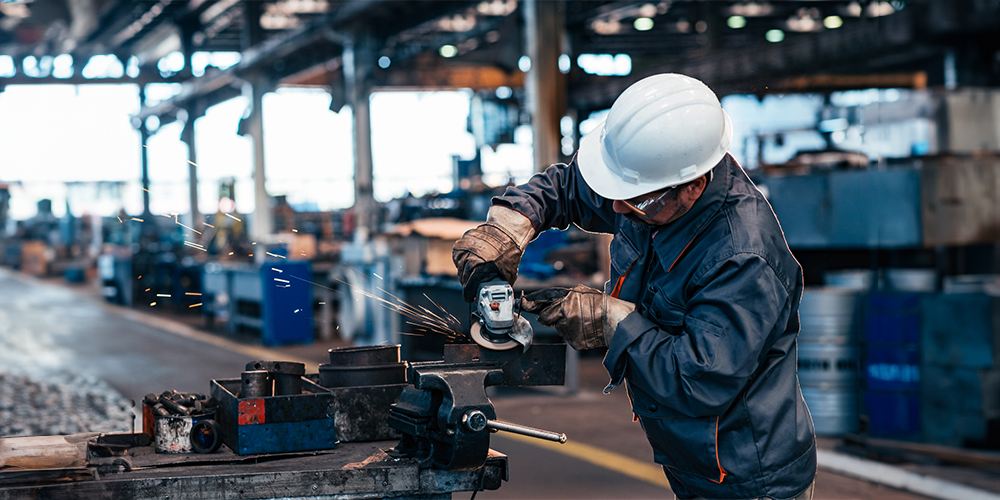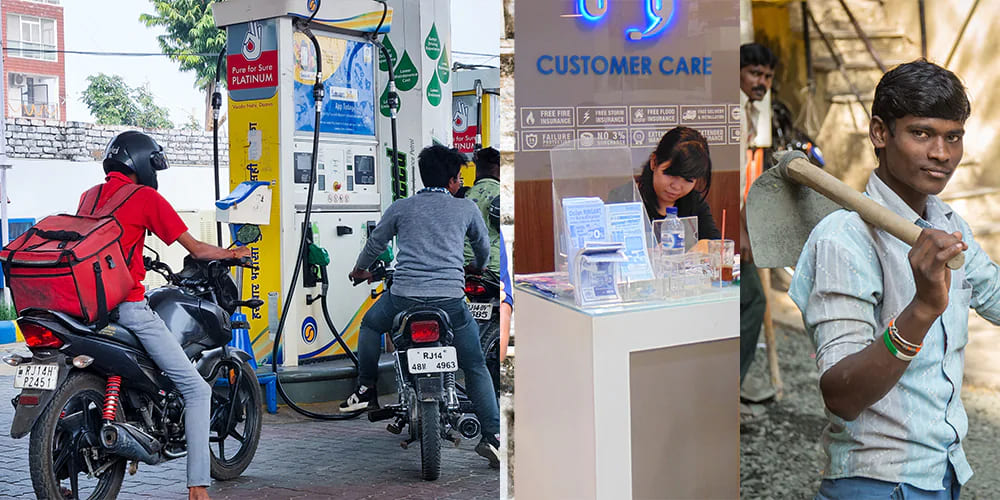Revitalizing and Transforming Manufacturing Sector in India

India’s manufacturing sector has witnessed diverse phases of evolution amid the COVID-19 pandemic. Accounting for around 16-17% of the country’s GDP, this sector plays a pivotal role by employing nearly 20% of the workforce. In FY23, manufacturing exports surged to an unprecedented $447.46 billion, marking a substantial 6% growth compared to the record set in the preceding fiscal year at $422 billion.
India stands as an appealing destination for foreign investments, particularly in the manufacturing sector. Diverse industries, including automobiles, luxury goods, and mobile phone manufacturers, have either established or are in the process of setting up production facilities within the country. The introduction of the Goods and Services Tax (GST) in India, with its massive population of 1.32 billion and a robust GDP of USD 2.5 trillion, is poised to reshape it into a unified market, attracting substantial interest from investors. Anticipating policy interventions, the Indian Cellular and Electronics Association (ICEA) envisions a substantial surge, projecting India’s cumulative manufacturing capacity for laptops and tablets to reach USD 100 billion by 2025.
Government Initiatives and Market Trends
To cultivate a conducive environment for the growth of India’s manufacturing sector, the government has set in motion various initiatives. In the Union Budget 2022-23, a significant allocation of Rs. 2,403 crores (equivalent to USD 315 million) was earmarked to promote the manufacturing of IT hardware and electronics. With a substantial Production-Linked Incentive (PLI) allocation of Rs. 760 billion (USD 9.71 billion) specifically for semiconductors, India has positioned itself as a leading global producer of this critical component.
To propel the core manufacturing sector to meet global standards, the Indian government has instituted multiple initiatives. Launched in 2022, the Production-Linked Incentive (PLI) scheme for manufacturing and the National Manufacturing Policy are key contributors to this endeavor. The National Manufacturing Policy sets an ambitious target of increasing the manufacturing sector’s contribution to GDP to 25 percent by 2025. Consequently, India is steadily advancing towards the goals set by Industry 4.0.
The Government of India’s Ministry for Heavy Industries & Public Enterprises has introduced SAMARTH Udyog Bharat 4.0, denoted as SAMARTH Advanced Manufacturing and Rapid Transformation Hubs. Envisioned to elevate the competitiveness of the manufacturing sector, particularly in the capital products market, this initiative is poised to make significant strides. With a focus on the strategic development of smart cities and industrial corridors, the government is committed to ensuring the holistic advancement of the nation. These corridors, designed to facilitate integration, monitoring, and the creation of a conducive environment for industrial development, are anticipated to propel forward manufacturing practices.
Challenges Confronting India’s Manufacturing Marvel
- Inadequate Tech-Based Infrastructure: The enhancement of competitiveness in the manufacturing sector relies heavily on innovation-driven infrastructure, particularly in areas such as transportation, communication, and skilled labor.
- Access to Credit for MSME: Unlike the medium and large-scale industrial and service sectors, the Micro, Small, and Medium-Sized Enterprises (MSME) sector faces more stringent challenges in securing credit and bears higher costs for working capital.
- Skilled Labour Shortages: The growth of the manufacturing sector in India is hindered by a shortage of skilled and competent workers.
- Complex Regulations and Poor Supply Chain: Numerous complex regulations, including tender, license, and audit, govern the manufacturing sector in India. These regulations can be difficult for businesses and inhibit their expansion. Additionally, inadequate supply chain management frequently plagues the industry, resulting in inefficiencies and increased expenses.
- Competition from Other Countries and Imports: Domestic manufacturers may find it challenging to stay competitive on the international market due to the intense competition from foreign countries. India continues to rely on foreign imports for various essentials, including transport equipment, machinery (both electrical and non-electrical), iron and steel, paper, chemicals, fertilizers, plastic materials, and more.
Transformative Strategies for Economic Advancement in the Manufacturing Sector
- A Call to Invest in Advanced Technology Infrastructure: Invest in the development of robust technology-based infrastructure, focusing on improving communication networks, transportation systems, and skill development programs. Collaboration between the government, private sector, and educational institutions can facilitate the creation of a skilled workforce equipped with modern technological capabilities.
- Strategic Policies to Empower MSME: Implement policies to enhance credit accessibility for Micro, Small, and Medium-sized Enterprises (MSMEs). This could include establishing dedicated financial institutions or specialised lending programs tailored to the unique needs of the MSME sector. Additionally, promoting financial literacy and simplifying loan application processes can facilitate easier access to credit.
- Bridging the Skills Gap: Address the shortage of skilled labour through strategic partnerships between industries and educational institutions. Promote vocational training programs and apprenticeships to bridge the skill gap. Incentivise businesses to invest in employee training and development to enhance the overall skill level of the workforce.
- Simplifying Business Landscapes: Streamline and simplify regulatory processes to reduce the burden on businesses. Adopt technology for regulatory compliance and provide assistance to businesses navigating complex regulations. Enhance supply chain management through the integration of digital technologies, real-time tracking systems, and collaboration platforms to minimise inefficiencies and optimise costs.
- Driving Growth through Competitiveness: Foster innovation and research and development to enhance the competitiveness of the domestic manufacturing sector. Implement trade policies that protect and support local industries without compromising global trade commitments. Encourage investment in critical sectors to reduce dependency on imports and explore collaborations with international partners to enhance competitiveness in the global market.
Driving India’s Manufacturing Sector into the Future
A burgeoning demand for computers, phones, TVs, and kitchen appliances is propelling India’s manufacturing sector forward. People are investing more in household appliances, particularly mobile phones, as a result of rapid urbanization and rising disposable income. This surge in demand points toward a promising future for manufacturers. To further encourage manufacturing in India, the central government has implemented tax exemptions on specific components and parts.
In addition to these initiatives, there are export incentives and lowered customs duties on imports of raw materials. Various measures have been implemented to amplify the Make-in-India initiative, fostering the manufacturing of electronic items that were previously imported and assembled in India. The shift to 5G, the advent of artificial intelligence, and the widespread implementation of IoT are fueling demand as individuals progressively embrace technology. Although in its early stages, the transition is anticipated to be swift, providing a strategic advantage for Indian manufacturers entering this dynamic segment.
Latest Blogs
Talent Acquisition vs Recruitment in Workforce Planning
In many boardroom conversations, “talent acquisition” and “recruitment” are used interchangeably, but the reality is, they’re not the same. While both deal with bringing people...
Read MoreEvolution of Human Resource Management in India
The evolution of human resource management in India is a compelling story of how businesses have transformed their approach to people. What started as a...
Read More5 Key Manpower Supply Strategies for Hiring Better Talent
In today’s competitive job market, ensuring a reliable manpower supply is critical for business continuity and growth. Whether managing large-scale operations or expanding your business,...
Read MoreBoosting Employment in Rural Areas Through Staffing & Skilling
Rural India is evolving. With nearly 65% of the population residing in villages, it is clear that the next phase of India’s growth story will...
Read MoreFinancial Impact of Attrition & Role of Recruitment Partners
That’s why understanding the actual cost of attrition is more crucial than ever. We at TeamLease keep on tracking and analysing data to come up...
Read More





